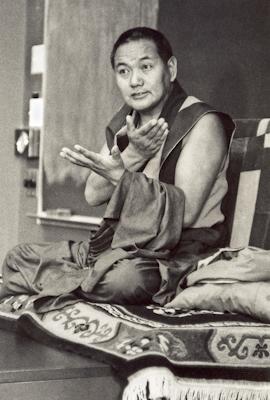The way we explain a yoga method is as follows. First we explain the qualifications that students need in order to receive the method and those that teachers need in order to give the initiation. Then we explain how students can keep their body, speech and mind pure and going in the one direction. Then we give the initiation and commentary and explain how to do retreat and what kind of realizations students can expect and how to gain them.
When we practice the yoga method, first we do the transcendent process of transformation, doing the absorption and then arising as the deity. Then we contemplate on the divine body of the deity and gradually reach the point of mantra recitation, where there are many different concentration techniques we can apply.
With certain deities these include techniques of mental recitation, such as the samadhi of fire and the samadhi of sound, where our concentration gets ever more subtle as we approach discovery of the dharmakaya, which is the essence of the buddha-mind, the totally open consciousness, the blissful state of universal wisdom.
In order to realize the dharmakaya we have to make a connection between it and our own fundamental experience. We have to create a link. It’s like shooting a gun—you have to have a target. When we meditate, we have to focus our energy on the dharmakaya, so there needs to be some kind of logical relationship between what we are practicing and the goal, the dharmakaya.
Therefore, we first transform our consciousness into the rainbow body and then transform our consciousness into sound. Then that too disappears into non-duality. By contemplating on that kind of deep experience—our wisdom contemplating on only the tiny, subtle object of sound and that subtle object of sound also disappearing—our wisdom is left embracing empty space. That helps us eliminate our dualistic mind and brings us closer and closer to the dharmakaya.
Beginners always have trouble holding the object when they first try to develop concentration and often get upset when it disappears: “I’m a terrible meditator; my concentration is so bad.” Don’t be discouraged. When the object disappears, you’re left with a kind of non-duality. Take advantage of that. Take that opportunity to bring yourself closer to the dharmakaya experience.
However, I’m not talking about your losing the object through sluggishness, through falling asleep. That’s no good at all. It’s when you’re trying to practice mindfulness but just can’t keep the object in mind. At that time, when the object—the sound, the deity, whatever it is—disappears, that’s OK. Just stay in the space of non-duality.
We have to develop gradually. Actually, to practice the last technique I mentioned, samadhi of sound, we’re supposed to have already attained the realization of calm abiding. What degree of concentration do you need to have attained before you can say you have realized calm abiding? You need to be able to meditate for twenty-four hours non-stop, without interruption, distraction, sluggishness or falling asleep. Some people find attaining this easy; others find it difficult. It’s a highly individual experience. You can’t ask, “How long does it take to attain calm abiding?” Some people can do it in a couple of months; others can take a year or more. It depends on the individual.
If you have that realization, that’s excellent. But even if you don’t, by doing retreat you will develop a certain degree of control over your mind; some ability to put it in whatever direction you want and keep it there. That’s very useful.































